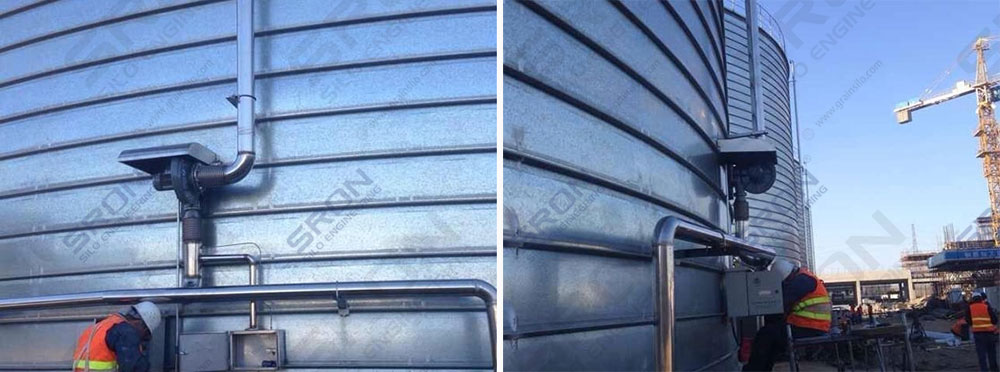
Aug.02, 2022Keywords:grain silo, steel silo, sron silo
.jpg)
The steel silo has thin walls, so it absorbs or dissipates heat quickly. If there is a temperature detection device in the silo, once the temperature changes, it can be detected in time and treated appropriately. Using the "four-in-one" grain storage technology, plus some existing grain processing technologies, such as cleaning, screening, grading, air suction and dust removal, as well as mature and complete management methods, such as silo dumping and automatic cooling system in the silo, etc., the steel silo must also be able to achieve safe grain storage.
.jpg)
Grain situation measurement and control
Using modern electronic technology to realize real-time monitoring, analysis, prediction and control of grain silo condition changes in the process of grain storage. The system consists of a measurement and control host and a measurement and control extension to form a measurement and control network. The measurement and control extension installed at each grain silo collects the grain condition data and aggregates it to the control center in a wired or wireless manner. The management personnel can grasp the food security situation in time through the host computer software, and control the opening and closing of related equipment automatically or manually through the software to achieve the purpose of cooling and dehumidification. The grain silo is equipped with electronic sensing elements to detect temperature and humidity, which is easy to operate, can control the temperature and humidity in the silo at any time, save and print data.
mechanical ventilation
The safe storage of wheat is mainly to prevent mildew, heat and pests in the grain silo. The key factors affecting it are the temperature and humidity of the grain pile and storage environment. Using intelligent mechanical ventilation, through the special design of air ducts, ventilation timing, temperature and humidity difference, air volume and exchange times, while taking into account the air network design of ventilation, fumigation and grain cooling technology, the temperature and humidity of the silo environment are controlled , in order to prevent the occurrence of food damage.
.jpg)
grain cooling
By cooling to control the temperature, the grain is kept in a low temperature state below 15°C or a quasi-low temperature state below 20°C, which can greatly slow down the "breathing" of the grain, ensure long-term storage and preservation of grain, and prevent grain insects from multiplying. The grain cooler, when the temperature of the grain pile in the silo exceeds the standard, sends the cold air generated by the grain cooler into the silo through the air supply system to achieve the effect of cooling the grain temperature. Grain cooling technology can maintain and moderately adjust grain moisture while cooling, and has three functions: moisture retention cooling ventilation, moisture reduction cooling ventilation and tempering cooling ventilation. It is an important technical measure for the preservation of green grain storage, maintaining and improving the quality of grain storage.
Fumigation for killing insects
Fumigation is based on the theory of granary theory, aerodynamic circulation theory and chemical control theory, using microcomputer control technology, using aluminum phosphide tablets to produce phosphine gas delixiation, through the circulation fumigation equipment, forcing air circulation, to promote that phosphine gas is evenly distributed in the grain silo to achieve the purpose of effective pest control. Phosphine circulation fumigation and insecticidal technology are used in the northern wheat storage silos. Using phosphine generators to inject, and 9 hours after the application is completed, it reaches a uniform state, and the fumigation control effect is good. In addition, using the high air-tightness of the steel silo, it can be filled with nitrogen, and the nitrogen in the main air duct enters the grain pile, flows evenly between the pores of the grain pile, discharges oxygen, playing a insecticidal effect. And it has a better pest control effect.

Notice
Grain moisture must not exceed the standard, and it need to meet the standard of grain silo storage. If the moisture exceeds the standard, the moisture inside the grain pile will show a tendency to slowly dissociate from the inside of the grain to its surface, and then to the air in the gap between the grains. It is difficult for grain moisture to escape from the stagnant air. It accumulates between grains, and it begins to condense when the wet state reaches the saturation point, resulting in mildew and rise of local temperature, threatening safety of grain. Be sure to do a good job of ventilation which can dissipate heat and moisture, maintain the stability of grain storage and reduce the moisture content of grain storage.
Please feel free to give your inquiry in the form below. We will reply you in 24 hours.